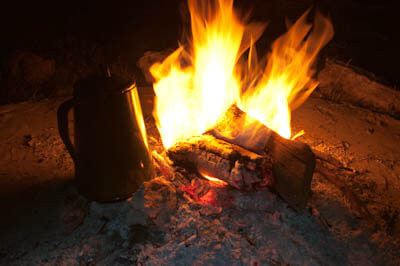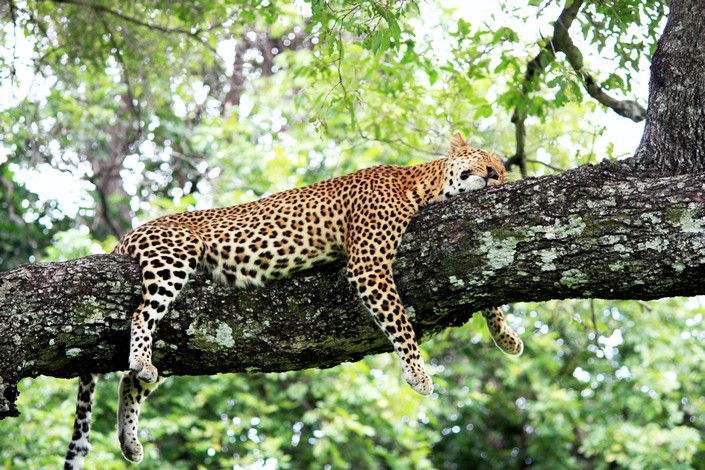Dr Bruce Paxton (Zoologist and lover of open fires under the African skies) and his girlfriend drove themselves through Botswana, heading for the Okavango. This is a very candid reflection of Dr Paxton’s experience of Africa, perhaps a few things we don’t want to hear, but needs to be said. But overall a descriptive, insightful and often humorous article about their travels.
Photography copyrighted by Dr Bruce Paxton
1. Where did you leave from and what route did you take?
From the Noordoewer border post in Namibia we headed to Tsumke in the northeast where we crossed Khaudum – a national park notorious for its deep sand and aggressive elephant. From Khaudum we followed the Kavango River into Botswana, staying at Shamvura and Ngepi lodges along the way. In Botswana we headed for Tsodilo Hills where we spent a few days before crossing back through the swamps to Guma lagoon at the neck of the Okavango panhandle. From there we drove south across the Trans-Kalahari Highway through Ghanzi and spent a night in Mabuasehube – the north eastern corner of the Kgalagadi Transfronteir Park. Finally we headed south from Mabuasehube and crossed the border back into South Africa at Bokspits north of Upington.
We took a hundred and fifty litres of fuel, a hundred litres of water, a closet-full of panties, Valiant Swart and an ingwala (a six foot long hardened steel digging crowbar, otherwise known as a ‘koevoet’.)
2. Why did you choose the Okavango?
The Okavango was just one of the places we wanted to visit – we also wanted to see Khaudum for its remoteness and Tsodilo for its spiritual significance to the Bushman and for its rock art which dates back several thousand years. Of course, the Okavango is a unique ecosystem, not just regionally, but globally. It is one of the few endorheic deltas in the world – meaning the waters of the Kavango River don’t flow into the sea, but dissipate into the sands of the Kalahari desert – 90 % of this water evaporates each year. The Okavango’s wilderness and wildlife value is inestimable and the experience of riding in a mokoro among elephants crunching through papyrus roots, hippos snorting in blue pools and endless fields of water lilies is an experience never to be forgotten – even for the most seasoned African traveller.
Kavango River from Ngepi Camp, Namibia
3. What vehicle did you use and how did you find the roads/route?
I have an old ’94 model Toyota Hilux, as strong, capable and unstoppable as its reputation suggests (it just takes its time to climb hills). I call it the Springkaan (grasshopper) because it hops over the most disconcerting terrain while shaking you to pieces in the process. For navigation I have a GPS unit connected to a PC. I track the route live on the PC while driving and use cached Google Earth images as a base map (that’s when I don’t fry the motherboard en route).
4. Approximately how many hours did you drive per day?
Between 4 and 5 hours.
5. What was the most picturesque area that you visited?
Okavango was undoubtedly picturesque, but the Kalahari affects the soul.
View into Angola across the Kavango River from Shamvura Lodge, Namibia
6. What animals did you see and tell us about your close encounters.
We didn’t see many animals – the experience of the bush is reward enough for me – but there were elephant in Khaudum and we were mock-charged by one in the mokoro – which is quite a different experience from being mock-charged while in a vehicle. At Guma lagoon one night I almost walked into a hippo the size of the Hilux. Fortunately I’d just changed the batteries in my LED Lenser head torch which is as bright as a lighthouse. When I switched the torch on the hippo decided to clear out. I don’t think the encounter would have turned out quite so well for me without the Lenser. He chomped his way around the Hilux for the rest of that night – the rooftop tent was worth the investment afterall.
At Mabuasehube a brown hyena prowled around our camp. They’re more uncommon and less aggressive than the spotted, so it was special to have it as a midnight guest. On the mokoro we saw two Pell’s fishing owl – an exceedingly rare and unusual bird which most birders only ever dream about seeing.
Bush squirrel, Shamvura Lodge, Namibia
7. Did you meet any interesting people, or experience new cultures?
Sadly, I wanted to spend time with the Bushmen, but found they were either desperately poor and on the margins of society both in Namibia and Botswana, or tour companies and safari lodges were charging exorbitant prices for the ‘authentic’ Bushman experience. I’m just not into that. There is nothing authentic about paying a people who have been abused and persecuted for centuries, dressing up and performing dances which have little meaning for them any longer. I’d rather see them in schools, or provided with decent health care. I chose to avoid them, interacting only if they approached to sell curios. I purchased a beautiful ostrich egg shell necklace outside Tsumkwe and wished I’d spent more time there – it seemed that here the Bushmen were reaching out to foreigners on their own terms. But the extreme wealth gap makes any authentic interaction awkward and insincere.
Oom Dirk was an interesting person. But he wasn’t a Bushman – not in any hereditary sense of the word that is. He was a dominee in Grootfontein and a proper ‘Suid-Vester’, a ‘South-Wester’ as we used to call them. We spoke long, a lot about Bushmen, which he had worked with for many years. He confirmed what I already knew – that they had broken with their past, that they struggled with their sense of dignity, that they were hurt and defeated and that many had sought refuge in alcoholic oblivion. But he confirmed other things that I had merely suspected – that they still had deep connections to the bush and that they were gentle even in their rage. At Shamvura Lodge Charlie Paxton (no relation) spoke of four Bushmen guides who shielded an Australian tourist from a bush fire with their bodies. Three of them died saving her.
8. Where and how did you camp at night?
I have a rooftop tent and mostly camped in designated camp sites in the parks or lodges. A rooftop is more or less essential if you have hippos, hyeanas or lions wandering around at night.
9. Tell us a bit about your love for Africa.
My love for Africa is ambiguous. Like many, I’m passionate about its wide open spaces, its wildlife its deep-time history and its diverse cultures. There are few more simple and rewarding pleasures than pulling up beneath a thorn tree with bush as far as the eye can see and building a fire beneath the stars. Some old part of my psyche responds to this simple act. But of course, Africa is not just about wide open spaces and wildlife. There are people living in Africa – quite a number of them in fact – and not all of them have the leisure to travel or to appreciate the value of its wide open spaces, especially if these spaces can’t fill the hole in their stomachs. So there is this delicate balancing act between the need to conserve wild Africa – something that has intrinsic value for all humanity – and the need to bring Africa into step with the rest of world without sacrificing every last shred of wilderness in the process. In between all these complex issues may be a space for love.
Kavango River from Ngepi Camp, Namibia
10. Was there anything you were not prepared for?
For the wild? No. I’m always prepared – I have an ingwala remember! But obtaining Botswanan Pula in South Africa was a bit problematic – it has to be ordered through local banks several days in advance.
11. As a zoologist, how did you experience Africa through those lenses?
As a zoologist I am always acutely aware of how ‘managed’ our natural world is. There are very few places one can go that are really wild in the deepest sense of the word. Even our national parks are very carefully orchestrated to enhance the visitor experience and provide maximum bang for the tourist buck. That’s why I wanted to go to Khaudum not Etosha – in Khaudum, although the pans are artificial, there is still the sense of space and distance and wildness. A new lodge is being built at Khaudum camp, so things may change there quite soon.
12. Were you made aware of any conservation issues?
A dam is being planned on the Kavango River that will impact the Okavango Delta. The Popa Falls Dam on Kavango River has been in the pipeline for many years. If they go ahead it will radically compromise the integrity of the Okavango Delta ecosystem. Environmental lobby groups and common sense have kept the proposal at bay thus far. But it seems the Namibian government is determined to go ahead with it. In doing so, they are putting the developmental needs of their country ahead of its environmental integrity. But if an ecosystem of global significance like the Delta is not sacrosanct, then what hope do we have for the rest of Africa’s wild areas? As if to outdo Namibia, the Botswanan government have begun fracking in the Central Kalahari, signs that they too are under immense pressure to maximise the use of their natural resources – either that, or they want to get rich quick. I’ll give them the benefit of the doubt. One way or another the outcome is the same for the Central Kalahari and the Delta – an increasingly managed natural world where the illusion of wild Africa is maintained just enough to keep the tour buses rolling and the four-by-four crowd engaged in low range.
13. Did you discover anything new about Africa?
There is nothing new under the African sun, it is all old, very old. You take from Africa what you want: an untouched Eden of water lilies in the desert, Bushmen prostitutes on the outskirts of Ghanzi. The same Africa, just different faces.
14. Where do you plan on travelling to next and why?
I want to travel into Botswana through the Kgalagadi Transfrontier Park and then cross the Central Kalahari. Why? Because there are a lot more thorn trees I want to sleep under, more sandy tracks for the Hilux to grind through, more campsites with less ablution facilities and more stars in the sky at night. Are there any better reasons?
Thank you Dr Paxton for sharing your journey with us. We look forward to your next adventure and wish you safe and glorious African star-filled travels!
Have a look at our Tours to Botswana











0 Comments